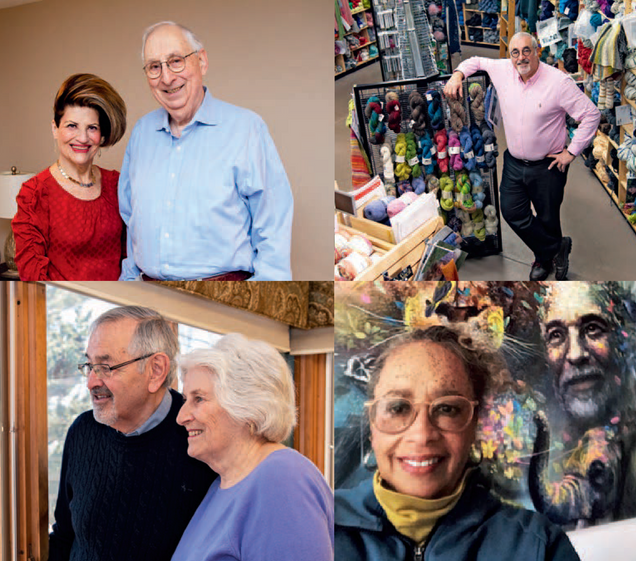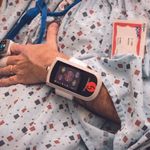A 75-Year History of Altruism Drives Historic Framingham Heart Study Science
Much of what we’ve come to accept as fact about heart disease comes from studying the more than 15,000 volunteers in the Framingham Heart Study (FHS), now celebrating its 75th anniversary.
“Without the participants, there is no science,” says Maureen Valentino, who has worked at the FHS research center for a quarter-century recruiting new participants and looking after volunteers in the nation’s longest-running human observational study.
“You will not find a researcher or scientist on the face of the earth who is not amazed at the dedication of these people. They come from literally all over the world to do the study and they do it faithfully.”
Doug Stein, a 52-year-old tax attorney from an Atlanta, Georgia, suburb and a third-generation FHS participant, embodies that altruism, dedication, and enthusiasm for research.
“You’re really providing information for the betterment of society— but not just our society, for the whole world,” says Stein, whose grandparents were in the first cohort of participants in 1948. Stein’s parents were in the second-generation study and his children are already asking when they will be included.
“I look at it as a gift to my kids. It’s a unique opportunity for them to participate in something much greater than they are; likely greater than they could ever realistically become,” says Stein.
Often referred to as the “jewel of cardiology,” the Framingham Heart Study’s research center fits into the modest footprint of a dozen wood-paneled examination rooms. On most weekdays, a half-dozen participants arrive at the facility for a five-to-six-hour examination that some of them liken to a supercharged physical.
 Clockwise from top left: Zelda and Arthur Stein, Peter Isaacson, Cheryl Brown, Ron and Linda Isaacson
Clockwise from top left: Zelda and Arthur Stein, Peter Isaacson, Cheryl Brown, Ron and Linda Isaacson
“Honestly, I really enjoy the tests. There hasn’t been anything they’ve asked me to do that I’ve said no,” says Samira Brown, MD, a pediatrician who grew up in Framingham and now lives in Georgia. Participants volunteer expecting no tangible reward, rarely miss an appointment over a lifetime of testing, and pass along that responsibility to their children and grandchildren. Researchers like Joanne Murabito, MD, FHS research center director and principal investigator, are both proud of and in awe of their dedication.
“This study is their study, and we could not have accomplished all that we’ve learned about the risk factors for heart disease, the occurrence of heart disease, all of the genetic and molecular factors related to heart disease, without their willingness to come in for the testing and be forward-thinking about all of these new areas of research,” says Murabito, who has worked at the research center for more than 30 years.
It was the death of popular US president Franklin Delano Roosevelt from a cerebral hemorrhage due to runaway hypertension that shone a light on the knowledge deficit around heart disease, the nation’s number one killer.
Renowned epidemiological cardiologist and longtime director of the heart study William Kannel, MD, first coined the term “risk factors,” largely preventable lifestyle choices like smoking, obesity, and high cholesterol that could bring on heart disease. Incredibly, Kannel and other top researchers were initially as unaware as the public was about them.
Kannel’s daughter Linda Isaacson, a second-generation participant, recalls cigarette, cigar, and pipe smoke hanging in the air of her family’s living room at the informal meetings of physicians and researchers affiliated with the study, even as they debated the possible causes and treatments of heart disease. “When they’d get together, they all used to smoke and when they found out it wasn’t good for them, they stopped,” she says.
Truman signed the National Heart Act, creating the National Heart Institute and dedicating $500,000 to a 20-year epidemiological study focused on cardiovascular disease that became the FHS. Almost right from the start, FHS research drove the science and public health policy surrounding heart disease and strokes, establishing links to smoking, obesity, hypertension, high cholesterol, and atrial fibrillation.
At the close of a world war, with mobilization and volunteerism for the common good still in the public consciousness, half the adult population of Framingham—5,209 people—signed up for the first round of the study. Doug Stein’s paternal grandparents, who immigrated from Russia and Poland around 1943 to escape the horrors of WWII, immediately agreed when asked to participate in the initial phase of the study.
“They felt that being immigrants, they owed the country something and this was payback; this was a way for them to help the country. It was a heartfelt emotion,” says Arthur, Doug Stein’s father and a second-generation FHS participant for nearly 50 years.
Succeeding rounds of funding extended the study’s life span, with 5,124 children of the original group of volunteers and some spouses recruited in 1971, followed by 4,095 third-generation children in 2002 and 103 of their spouses in 2003. Until the 1990s, recruitment had been generational through families and 100 percent white European Americans.
To reflect an increasingly diverse town and nation, the study established two new groups referred to as the Omni cohorts, comprising African Americans, Hispanic Americans, Asian Americans, among others, with 507 participants recruited in the 1990s and an additional 410 of their children from 2003 to 2005.
Samira Brown’s mother Cheryl said she and her husband initially had reservations about participating given how Black people had historically been treated in other medical studies. Her husband Leonard Brown, an associate professor of music at Northeastern University, decided against it.
“I don’t think he distrusted the Framingham Heart Study, but he said, ‘On principle, I’m not going to participate.’ But my position was, I want to do everything I can to have an impact on the health of future generations—my own, my children’s, my grandchildren’s,” says Cheryl Brown.
In her medical residency program when the invitation came, Samira Brown decided that the FHS was open, transparent, and important—and signed up. She convinced her brother to join, too. “It is very empowering for me to be able to do something as a participant and as a Black physician. As we battle these health disparities, [diversity and inclusiveness] really are important and I think the Framingham Heart Study is a great model,” she says.
One of the reasons for the study’s longevity is its personal approach with participants, notes Christine Hess, the research center manager.
“I think the culture of the place exudes appreciation,” says Brown.
Framers of the research made two critical decisions early on that have helped it endure. They incorporated women, which was rarely done in longitudinal studies at the time, and they decided they’d recruit within families, hoping that familial pressure would help ensure cooperation and provide new sources of study participants. This also inadvertently created a generational database that then-undeveloped science of genetics could use to look at links that might predispose someone to heart disease, even without other risk factors.
“When I was interviewing third-generation participants—the grandchildren of the original participants—they said, ‘I’m here because my grandmother told me to come in.’ So, there is a real family commitment to giving back, and to participating in the science. I heard that a lot,” says Murabito.
Like his parents before him, Arthur Stein didn’t talk much about his participation. Since the 1970s, whenever his exam date came up he’d tell his employer and family that he had a medical appointment, then travel to Framingham from Schenectady, New York, where he worked as a nuclear engineer, and then from Sharon, Massachusetts, after the family moved there.
While he doesn’t have the cross-country commute of his brother in Washington State, Doug Stein still needs two or three days off to fly in from Atlanta, Georgia, which he views as time to tune out of his hectic life and focus on himself. Like the Browns, Isaacsons, and Stein families, he has never missed an appointment.
“Even when I go on vacation, I’m always on the cell phone, always emailing,” he says. “When I go to the Framingham Heart Study, my phone’s off. You can call me, but I’m not going to answer.”
While the core exam is funded for six-year intervals, the 60 to 70 FHS-affiliated researchers use grant money to pay for ancillary studies. Cheryl Brown says she’s volunteered for many over the years, including cognitive research that has her traveling back to Framingham from her Bethesda, Maryland, home every few months.
Circulatory system and heart health affect many other organs and, almost right from the start, additional tests have been added to the core exam. Murabito points out that a particularly big shift took place a little more than five years ago when the primary funder, the National Heart, Lung, and Blood Institute, expanded testing to incorporate other organs and systems impacted by the circulatory system including pulmonary, brain, bone, and cognitive function.
The FHS had always employed cutting-edge tools, and testing grew to incorporate technologies like electrocardiogram, magnetic resonance imaging, computed tomography, bone density scanning, and echocardiogram. With miniaturization, testing has expanded to wearable devices like EKGs and a blood glucose monitor that participants take home for 10 days.
 Testing has expanded to wearable devices.
Testing has expanded to wearable devices.
Ancillary tests are approved by a panel for safety and efficacy, says FHS Recruitment Manager Valentino. Participation is strictly voluntary, but many do so because they trust the staff and want to help. “If it’s associated with the heart study, then yes, I’ll sign up,” says Max Chang, an energy consultant from Sudbury, Massachusetts, who’s been a participant, including in many ancillary studies, for the past two decades. “I’ve done everything. I’m a willing participant.”
Murabito says that longitudinal studies typically don’t last 20 years, and she doesn’t know of any that have even come close to the FHS’s 75. It’s the loyalty and dedication of participants that has allowed the study to continue and allowed researchers to see risk factors play out over a lifetime, something known in genetic medicine research as deep phenotyping.
Soon to span four generations, the FHS database offers researchers a window into the biology and biologic pathways linking the gene to the disease, which could help identify new medications and treatments.
“When we have an association with the gene and a biologic pathway, you can then target for medication treatments to prevent cardiovascular disease or other diseases of interest and really understand what is causing the risk for those diseases,” says Murabito.
FHS research has helped produce new treatments like blood pressure medications and has changed the conversation from heart disease being an inevitable consequence of aging to smoking cessation and healthier diets.
According to the National Institutes of Health, deaths from heart disease dropped from a peak of nearly 750,000 in 1968 to 365,000 in 2014, with half of that decline attributable to reducing the impact of those risk factors through lifestyle and diet changes.
Arthur Stein looks back on his 40 years as a participant and his family’s involvement over the entire 75 years of the study with a sense of mission and pride.
“The Framingham Heart Study, at least from my perspective, was on the forefront of technical and medical research to prolong people’s lives,” says Stein. “I feel proud I was a part of that.”
The Framingham Heart Study is hosting a 75th Anniversary Celebration on Wednesday, Oct. 25, from 2-7 p.m. at their research center, 73 Mount Wayte Ave., Framingham. The event is for study participants, their families, staff, researchers and experts. Another celebration is planned for the spring of 2024 and will be open to the public.
View all posts